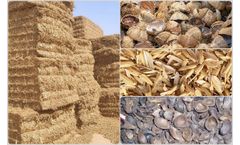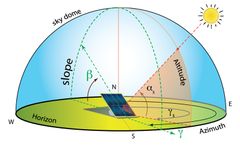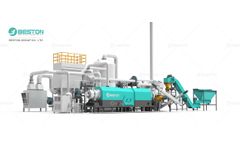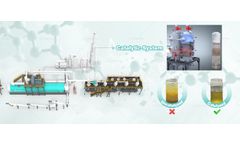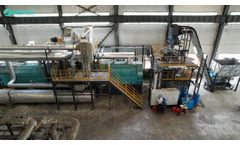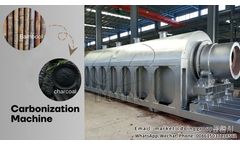Energy Material Efficiency Articles & Analysis
1,471 articles found
Societe De Cogeneration Picardie Socopic (SO.CO.PIC) is a producer and distributor of steam and air conditioning. SO.CO.PIC was searching for the right solution to renovating their old and oversized 40 MWe combined heat and power plant (CHP). Due to the French government's strategies and policies to promote sustainable energy and medium scale CHP, SO.CO.PIC decided to replace the aged gas turbine ...
The Lucart Castelnuovo di Garfagnana tissue mill is part of the Lucart Group, one of the first European paper and tissue producers. The mill has inaugurated its combined heat and power (CHP) system which is comprised of a Taurus™ 70 gas turbine generator set, an air system with fans, burners, dampers, ducting and instrumentation for the hood, as well as a heat recovery steam generator, an ...
Arizona State University's (ASU) historic main campus in Tempe, Arizona is a thriving urban undergrad, graduate, and research campus with 51,500 students. ASU ranked first in U.S News and World Report's list of "Most Innovative Schools" and among the "Best Graduate Schools" in the nation in 2019. The Sierra Club (2018) ranked ASU fifth overall in sustainability and Times Higher Education (2018) ...
Eastern Michigan University (EMU) is located in Ypsilanti, Michigan, approximately 35 miles west of Detroit and 8 miles east of Ann Arbor. It was founded in 1849 as a small teachers college and today has grown into a major public learning and research institution with over 21,000 students. EMU historically has been a leader in energy efficiency and sustainability. In 1987, the University ...
For more than 170 years, the name Hood® has been synonymous with fresh, quality dairy products that taste great. Founded in 1846 in Charlestown, Massachusetts, by Harvey Perley Hood, the company has since extended its New England roots, and today Hood is a national company distributing dairy products throughout the United States. In fact, HP Hood LLC is now one of the country’s largest ...
Santa Cruz, California, enhancing sustainability and reducing operational costs: Solar Thermal System: This system comprises 18 flat-plate solar thermal panels paired with a 1,200-gallon storage tank, supplying domestic hot water to meet the needs of hotel guests and ...
This 2,560-square-foot off-grid commercial solar installation in California is a prime example of renewable energy solutions for factories and businesses looking for self-sufficient solar energy systems. Constructed from eight 40-foot container boxes, the facility is designed for versatility and sustainability, featuring a 720-square-foot medical lab, a full kitchen, showers, office space, a ...
Forestry Waste Forestry waste, such as wood, branches, and bamboo, is also an important raw material for biochar production. These wastes are typically rich in organic matter, making them suitable for efficient conversion into biochar. ...
How modern LFP technology — and RICHYE’s quality-focused approach — lowers total cost, boosts uptime, and simplifies maintenance for long-term outdoor lighting Street lighting is no longer just about poles and lamps. Today’s solar street light systems are integrated energy solutions that combine photovoltaic (PV) panels, intelligent controllers, LED fixtures, and — ...
The coconut tree (Cocos nucifera) is one of the world’s most versatile and valuable plant species. Capable of producing food, fuel, cosmetics, building materials, growing media and cosmetic compounds, it’s no wonder that in the Philippines, the coconut is known as the Tree of Life. The global market for coconut products is predicted to reach $53.4 billion by 2033, thanks to annual ...
Figure 1 Solar Power Plants (SPP) are a renewable energy source. Among these energy sources, SPPs are among the most common and environmentally friendly systems. However, the efficient operation of a SPP project is directly related not only to the panel quality but also to the zenith, azimuth and altitude angles where the panel is positioned. Therefore, in this article, we will technically answer ...
Operating costs encompass feedstock acquisition, energy input for pyrolysis, and routine maintenance. Efficient thermal insulation and optimized combustion cycles reduce fuel consumption, directly enhancing net profitability. ...
By incorporating specialized catalysts into the pyrolysis process, industrial operators can significantly improve oil yield, enhance product quality, and optimize energy efficiency. This methodology is increasingly relevant in facilities processing heterogeneous waste streams, such as plastic, biomass, and mixed municipal refuse. Mechanism and Process Advantages ...
Expert tips and modern tech insights to keep your RICHYE power system running longer When you hit the open road in your RV, your battery bank is the silent workhorse behind lights, appliances, and creature comforts. Yet many RVers unknowingly shorten their battery’s life by overlooking critical maintenance routines and charging best practices. With advances in lithium iron phosphate ...
Driven by rising demand for clean energy alternatives and efficient biomass utilization, this sector attracts investors seeking high returns with moderate operational risk. ...
Pyrolysis technology has become a cornerstone in waste-to-energy and carbon-negative operations. Central to its efficiency and output quality is the pyrolysis reactor—where thermal decomposition of organic materials occurs in the absence of oxygen. ...
As global emphasis on energy efficiency intensifies, advancements in pyrolysis technology have shifted toward optimizing heat utilization and minimizing energy loss. ...
Excessive moisture leads to higher energy consumption, while overly dry feedstock may combust prematurely. ...
Selection and pretreatment of bamboo materials The quality of bamboo is the basis of carbonization effect. Different types of bamboo have different densities, fiber structures and moisture contents, which affect the uniformity and efficiency of carbonization. ...
The first few months of 2025 have been among the most economically turbulent in recent history, but despite this there are still signs anaerobic digestion (AD) will continue to play a key role in boosting energy security, tackling climate change, and managing organic wastes. The global biogas market was estimated to be worth USD 65.53 billion in 2024 and is projected to expand 4.2% per year ...



